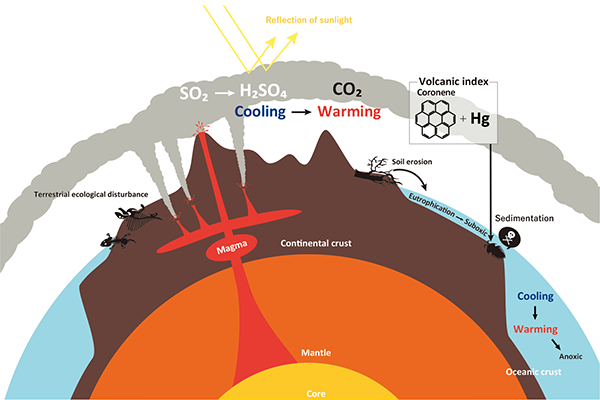Nov 11 2020
A more concrete proof of the volcanic cause of the huge mass extinction of life has now been found by scientists from Japan, the United States, and China.
 The researchers found coronene-mercury enrichments in sedimentary rocks deposited in southern China and Italy 252 million years ago. Paired coronene-mercury enrichments are products of multiple phases of a large igneous province volcanism. This, they say, could have led to the environmental changes that caused the disappearance of many terrestrial and marine animal species. Image Credit: Kunio Kaiho.
The researchers found coronene-mercury enrichments in sedimentary rocks deposited in southern China and Italy 252 million years ago. Paired coronene-mercury enrichments are products of multiple phases of a large igneous province volcanism. This, they say, could have led to the environmental changes that caused the disappearance of many terrestrial and marine animal species. Image Credit: Kunio Kaiho.
The study analyzed two discrete eruption events: one that scientists did not know earlier, and the other that led to the extinction of huge swaths of marine and terrestrial life.
Five mass extinctions occurred since the distinct evolution of early animals 450 to 600 million years ago.
The third was the most extensive of all and is believed to have been brought about by the eruption of the Siberian Traps—a vast volcanic rock region called a large igneous province. However, the correlation between mass extinction and the eruption is yet to be explained.
Researchers have detected sedimentary mercury enrichments, which are proxies for huge volcanic events, in several sedimentary rocks from the end of the Permian. Although deposits of such rocks have been discovered inland, in central oceans and shallow seas, their interpretation has been uncertain to date.
Sourcing of mercury can be performed from direct atmospheric deposition from volcanic emissions and riverine inputs from terrestrial organic matter oxidation during plant or land devastation—denoted as a terrestrial ecological disturbance.
The most extensive mass extinction took place at the end of the Permian—approximately 252 million years ago. During this mass extinction, there was a shift from the divergence of the Paleozoic reptiles and marine animals such as trilobites and brachiopods to Mesozoic dinosaurs as well as marine animals such as mollusks. About 90% of species were extinct at the end of the Permian.
Kunio Kaiho current professor emeritus at Tohoku University, headed a research team that investigated the potential triggers of the most extensive mass extinction.
They collected sedimentary rock samples from two places—Italy and southern China—to examine the organic molecules and mercury (Hg) contained in them. They determined two discrete coronene-Hg enrichments coincide with the initial terrestrial ecological disturbance and the ensuing mass extinction in both regions.
We believe this to be the product of large volcanic eruptions because the coronene anomaly was formed by abnormally high temperature combustion. High temperature magma or asteroid/comet impacts can make such a coronene enrichment.
Kunio Kaiho, Professor, Tohoku University
“From the volcanic aspect, this could have occurred because of the higher temperature combustion of living and fossil organic matter from lava flows and horizontally intruded magma (sill) into the sedimentary coal and oil. The different magnitude of the two coronene-mercury enrichments shows that the terrestrial ecosystem was disrupted by smaller global environmental changes than the marine ecosystem. The duration between the two volcanic events is tens of thousands of years,” added Kaiho.
Intense volcanic eruptions can generate sulfuric acid aerosols in the stratosphere and carbon dioxide in the air, which leads to global climate changes. It is regarded that this quick climate change caused the loss of land and marine creatures.
Coronene is known to be a highly condensed six-ring polycyclic aromatic hydrocarbon, which needs considerably higher energy to form than smaller PAHs. Therefore, high-temperature volcanic combustion can result in coronene enrichments.
This implies that high-temperature combustion of hydrocarbons in the sedimentary rocks by the lateral intrusion of magmas led to the formation of CH4 and CO2, resulting in high pressure and eruption that trigger global warming and mass extinction.
At first, the coronene-mercury concentration indicated that volcanic hydrocarbon combustion added to the extinction via global warming. Currently, Kaiho’s group is analyzing other mass extinctions to gain further insights into the cause and processes underlying them.
Journal Reference:
Kaiho, K., et al. (2020) Pulsed volcanic combustion events coincident with the end-Permian terrestrial disturbance and the following global crisis. Geology. doi.org/10.1130/G48022.1.